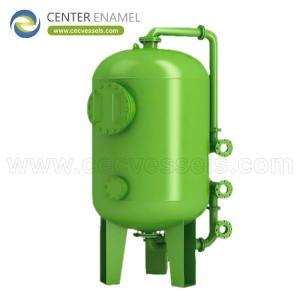Centrifugal Separators: Advanced Separation Technology for
Efficient Industrial and Environmental Applications
Shijiazhuang Zhengzhong Technology Co., Ltd (Center Enamel), a
global leader in advanced industrial processing and environmental
solutions, recognizes centrifugal separation technology as a
breakthrough in liquid-liquid, liquid-solid, and multi-phase
mixture separations. This comprehensive article, designed as an
authoritative marketing resource, presents an in-depth overview of
centrifugal separators, covering their working principles, design,
types, applications, benefits, and maintenance best practices. The
article highlights how Center Enamel integrates cutting-edge
centrifugal separation technology into its broad equipment
portfolio to meet the evolving needs of industries worldwide.
What is a Centrifugal Separator?
A centrifugal separator, also known as a centrifuge, is a
mechanical device that utilizes centrifugal force to accelerate the
separation of components with different densities in a fluid
mixture. Unlike traditional separators relying primarily on
gravity, centrifugal separators magnify the effect through rapid
rotation—enabling high-speed, precise separations often
unattainable by gravity alone.
Working Principle
Centrifugal separators work by feeding a fluid mixture into a
rapidly spinning rotor or bowl. The rotation generates centrifugal
forces many times stronger than gravity, pushing heavier particles
or denser liquid phases radially outward toward the bowl's
periphery. The lighter phases remain closer to the rotor's center.
The separated substances are diverted to appropriate outlets:
- Heavier solids or liquids accumulate at the perimeter.
- Lighter liquids move inward.
- Solids may be periodically scraped or discharged automatically.
This dynamic process allows continuous, efficient separation of
emulsions, suspensions, or mixtures with fine particulates.
Structural Components
Typical centrifugal separators include:
- Rotor/Bowl: The central spinning chamber where separation occurs.
- Drive Mechanism: Motors or engines powering rotor rotation, often reaching
thousands of revolutions per minute (RPM).
- Feed Inlet: Entry point directing the raw mixture into the rotor.
- Discharge Ports: Separate outlets for clarified liquids, heavier liquids, and
solids.
- Scraper or Discharge Device: Removes collected solids from the bowl.
- Control Panel: Enables monitoring, speed adjustments, and operational parameters.
Key Types of Centrifugal Separators
- Disc Stack Centrifuges: Equipped with a series of conical discs to increase separation
surface area, enhancing separation efficiency of fine particles and
emulsions. Widely used in dairy, beverage, petrochemical, and
pharmaceutical sectors.
- Solid Bowl Centrifuges: Designed to separate solids from liquids continuously, with solids
collected inside the bowl and periodically discharged. Used
extensively in mining, wastewater, and food industries.
- Pusher Centrifuges: Feature a mechanical pusher to continuously remove solids cake
from the bowl surface. Ideal for dewatering and recovery
operations.
- Decanter Centrifuges: Horizontal units separating solids and two liquid phases with
continuous solid discharge. Common in oilfield drilling, sludge
treatment, and chemical processing.
- Hydrocyclones: Simplified centrifugal separators using tangential feed and vortex
formation for particle-liquid separation, typically in mining and
mineral processing.
Industrial and Environmental Applications
Given their versatility and efficiency, centrifugal separators have
a broad range of applications:
- Oil and Gas: Separation of oil, water, and solids in produced water;
purification of lubricants and fuels.
- Wastewater Treatment: Dewatering sludge, removing fats, oils, and solids prior to
biological treatment.
- Food and Beverage: Clarifying juices, wine, oils, and dairy products; recovering
valuable solids.
- Chemical Processing: Separating catalysts, emulsions, and process sludges.
- Pharmaceuticals: Purifying products, separating cells, and recovering solvents.
- Mining and Minerals: Concentration and recovery of valuable minerals and solids.
- Power Plants: Cleaning condensate and cooling water systems.
Advantages of Centrifugal Separators
- High Separation Efficiency: Capable of separating very fine particles and stable emulsions.
- Rapid Processing: Continuous operation with high throughput.
- Compact Footprint: Smaller than comparable gravity-based separators.
- Versatility: Handles diverse mixture types and phase compositions.
- Automated Operation: Many models include remote controls and automated solids
discharge.
- Reduced Chemical Use: Mechanical separation reduces dependency on chemical additives.
Design and Operational Considerations
- Material Selection: Corrosion-resistant alloys and coatings withstand aggressive
fluids.
- Rotor Speed: Higher RPMs increase separation force but must balance mechanical
stress.
- Throughput Capacity: Proper sizing to match process demands.
- Maintenance Access: Design for easy inspection, cleaning, and component replacement.
- Energy Efficiency: Optimization of power consumption for sustainable operation.
Integration into Industrial Systems by Center Enamel
Center Enamel customizes centrifugal separators as part of
integrated plant solutions, employing:
- Precision engineering for optimal rotor design and balance.
- Advanced control systems for real-time performance monitoring.
- Modular construction enabling easy installation and scalability.
- Compliance with international standards ensuring safety and
reliability.
Maintenance and Best Practices
- Regular cleaning of rotors and discharge systems to avoid buildup.
- Scheduled inspections for wear, corrosion, and imbalance.
- Proper lubrication and calibrations to ensure smooth operation.
- Immediate repair of leaks or mechanical faults.
Centrifugal separators represent a critical technology for
efficient, high-throughput separation in industries where purity,
process control, and environmental compliance are paramount.
Leveraging principles of physics and mechanical engineering, these
systems enable rapid, reliable, and automated separations
surpassing conventional methods.
Shijiazhuang Zhengzhong Technology Co., Ltd (Center Enamel) stands
as a leader delivering state-of-the-art centrifugal separators
tailored to industrial needs–backed by expertise, quality
manufacturing, and a commitment to sustainable solutions worldwide.
For consultation, customized designs, or detailed technical
documentation, Center Enamel is your partner for advanced
centrifugal separation technology equipped to meet the challenges
and opportunities of global industry.


